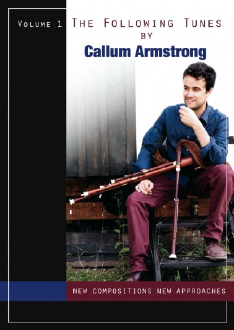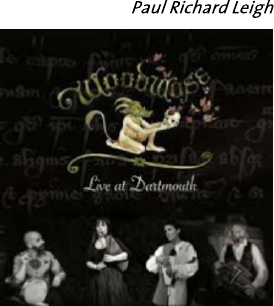The Bagpipe Society
Book Reviews
Book: The Following Tunes (Volume I) by Callum Armstrong - Jon Swayne
The Following Tunes (Volume I) by Callum Armstrong is a snapshot of this remarkable musician’s recent or not so recent bagpipe compositions. As he says in his introduction, its publication was in response to encouragement from friends and workshop participants. Its appearance will surely be welcomed by them. Such is the speed at which he responds to new stimulus in the way of instruments or playing partners, that it’s unlikely to be representative of the present state of affairs for very long, and soon they will be clamouring for Volume II. But first things first. Callum sets himself and us a very high standard and those who are familiar with his playing will appreciate that I approached this review with some trepidation. But there is no need to worry – the book is welcoming. Callum is a man with a great sense of style and fun, and this first collection of some of his bagpipe tunes exhibits those qualities in no uncertain terms. The book itself is beautifully presented, with as I say, a great sense of style, and plenty of high quality photos – mostly of the man himself with his various bagpipes, but also of his various musical collaborators. At the same time the photos show off the instruments clearly, and if that was the intention, it was a good one. Every part of this book oozes quality. The technique of printing white on black is not one I’m usually fond of, but here it succeeds in presenting much of the commentary material in nice contrast to the orthodox black on white of the manuscript and main text, often with an inset photo.

And so to the heart of the matter, the music. Here we have twenty-two pieces, arranged in four sections relevant to each of the four different pipes for which the music was composed, and a small fifth section for ensemble music. The order of the sections reflects, I think, the order in which Callum came to each instrument, so we have first Highland Pipes, followed by Smallpipes, Double Chanter pipes, Border Pipes, and Duets and Quartets.
Callum explains that he had an orthodox training in highland pipes from the age of fourteen, so you could expect the tunes in the Highland section to be highly idiomatic, and so they appear to be – three jigs, and an air which though extremely simple is logically constructed and very affecting. I say ‘appear to be’ simply because I lack expertise in highland repertoire, and an exception must be made for perhaps the most interesting of the jigs, Mudlark. This uses minor thirds and sixths and even a sharp seventh, and so would be ‘deemed incorrect’ in highland circles, as Julian Goodacre once informed me was the usual response to the introduction of notes beyond ’the nine’. Besides exhibiting highland tricks such as triplet repetition of high A and the impression of staccato melodic notes by alternating them with the comparatively ‘dead’ high A, the tune also shows Callum’s liking for unusual melodic leaps and chromatically shifting harmonies, which appear more explicitly later in the book.
In the Smallpipe section there are four tunes. The first, Rush Hour, is a reel full of complexities such as staccatos produced by stopping the chanter on the knee, and rhumba rhythms. To achieve the first, you would need a chanter without vent holes, or perhaps a Northumbrian chanter.
Lament for the Bees is a lovely air where the recommended drones form a minor triad, a C natural as well as A and E.

The second time through Callum shows his extended technique for the chanter by writing a slightly altered version of the tune one octave higher, with major as well as minor sevenths. Red Vespers is a nice 9/8 jig written in E minor and extending to high G, so would go well on D border pipes, but on smallpipes I’m not sure. Dixon Prelude was written as an intro to William Dixon’s tune Little Wee Winking Thing. As this is one of the few Dixon tunes which I have got to grips with, I can see that this prelude starts with the first four notes of LWWT and then goes off into flourishes up into the airy regions, but there is a version for G chanter (I presume border) which lies between F and second octave C.
At first sight the Double Chanter section would appear to be the least accessible, certainly to those lacking the requisite chanter, and even then a great deal of practice would be needed to master the intricate fingerwork. On the other hand there is nothing to say that these tunes would not make great duets, though even playing just one line of the reel Chasing Chickens (which is continuous semi-quavers and therefore black on the page) would present a challenge! White House Waltz is beautiful, in the style of a chaconne and I loved playing it on the piano. It reminded me of a tune by French accordionist Bruno Le Tron (which in my book is a compliment…). Angie’s Jig and Prelude to a Torrent (air) complete the section.
The last two sections may be the ones most attractive to this readership, designed as they are for playing on border pipes of the chromatic, overblowing kind. The selection starts with Borderline which at first looks like a straightforward jig in E minor – unusual on a G pipe perhaps – but playable, but then you find that it repeats in A minor then in F# minor and D minor before returning to E minor; that’s just the As. As far as I can see the Bs are all different, with chromatic harmonies creeping in towards the end. Fiendish! After that it’s a relief to find two fairly simple Schottisches in D minor and E minor, First Fall and Femme Fatale – just good tunes, the first with interesting syncopations, and both with great harmonies written as chord symbols, and a smooth mazurka with minor/major feel. Did I just say ‘fiendish’? - Nicolaus Copernicus (Reel) is insane; written out first for A chanter and in C# minor (that’s four sharps, folks) with lots of chromatics, repetitions and leaps. Callum has thoughtfully provided a transposition for G chanter, but it’s still mad….
I’ve never before seen a dynamic marking in a bagpipe score, but there is a forte marked at the beginning of the next tune, a 3/8 bourrée called Ripple Mill. Perhaps it’s not supposed to be there. Like a lot of the tunes it’s very notey, but it ripples along nicely like the title. I particularly like the Cadd9 chord in the third bar! (C9 is even better).
What did I say about the double chanter tunes making good duets? Here is Angie’s Jig again written out on two lines in A minor. Should be good fun to try.

Heading the final section of Duets and Quartets is a double page photo spread of Callum and Mattis Branschke sharing a joke. Their duo wowed us at the Blowout. Gigantic Orange Monkey is a hornpipe duet of not too challenging dimensions with some nice chromatic twists. Sleepy Summer Lanes, another duet, although apparently inspired by country roads makes me feel as though I have a boy racer on my tail. It’s quite accessible though, except for the middle section which calls for some extremely agile leaps and low D#s which you may not have.
Finally, we have Road to Rouen, an air for four G pipes and a jig for two Gs and two Ds. It’s quite a challenge to write meaningful four parts for instruments at the same pitch but the air works well, having a minimalist feel to it, as does the jig, but there the parts are easier to lay out with the D instruments. I think both would be highly enjoyable to play.
There’s no doubt that much of this music is challenging, but then Callum is a virtuoso performer and he must feed his ability with appropriate material – material which maybe only Callum will succeed in mastering but that doesn’t mean that we can’t or shouldn’t enjoy trying. On the other hand, there are some simple airs suitable for any level and in the end there is something for everyone. There is no shortage of hurdles for the advanced player and plenty of challenges to the usual ideas about how bagpipes should be played.
A bonus is an ample introductory essay by Julian Goodacre on Callum’s history and background, with some revealing insights into his approach to music, much of it informed by their longstanding pipe-making collaboration.
Have I any niggles? - nothing much. I would have liked the quartet Road to Rouen to have been written out as a score with all four parts visible at once. As it is you have to have four copies of the book to be able to play it. Doh! That’s why….. But it would make it easier to see how the four lines relate to each other. And I wondered about the reason for the phrase marks (slurs) in this piece; perhaps they help to reveal the ‘shape’ of the music, but if here, why not elsewhere, and there is some inconsistency in the scoring of repeated and tied notes. Also, I think the Schottisches would have been better notated as eight bar phrases in 2/2 with double the note value.
But none of that is important. Above all I think this is a marvellous piece of work. As I implied at the start, this collection is infused with Callum’s enthusiasm, creativity and sense of fun. It’s a shot in the arm, or perhaps that should be both arms.

- Data Processing Notice (GDPR)
@BagpipeSociety on X (formally known as Twitter)
TheBagpipeSociety on Instagram
 BagpipeSociety on Facebook
BagpipeSociety on Facebook
Something wrong or missing from this page? Let us know!
